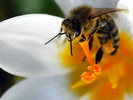 Researchers from Germany and New Zealand have reviewed Medihoney — a medically certified honey licensed for professional wound care in Europe and Australia.
Researchers from Germany and New Zealand have reviewed Medihoney — a medically certified honey licensed for professional wound care in Europe and Australia.
The authors cover its proposed mechanism of action and effectiveness in a range of conditions.
Most interesting are the safety data.
Pain
- About 5% of the authors’ patients report stinging pain after administration.
- In some of these patients, treatment with medical honey had to be stopped or postponed until after the acute inflammatory process was controlled by other approaches.
Allergic reactions
- 2 of 150 patients showed reproducible local allergic reactions to Medihoney.
- However, they had a history of atopy before treatment.
- No systemic reactions have been reported.
The bottom line?
The authors believe more studies are needed. However, based on what’s known, they encourage Medihoney as “an alternative treatment approach in wounds of different natures.”
More on its mechanism of action is posted here.
It’s antibacterial action is discussed here.
5/27/09 22:49 JR